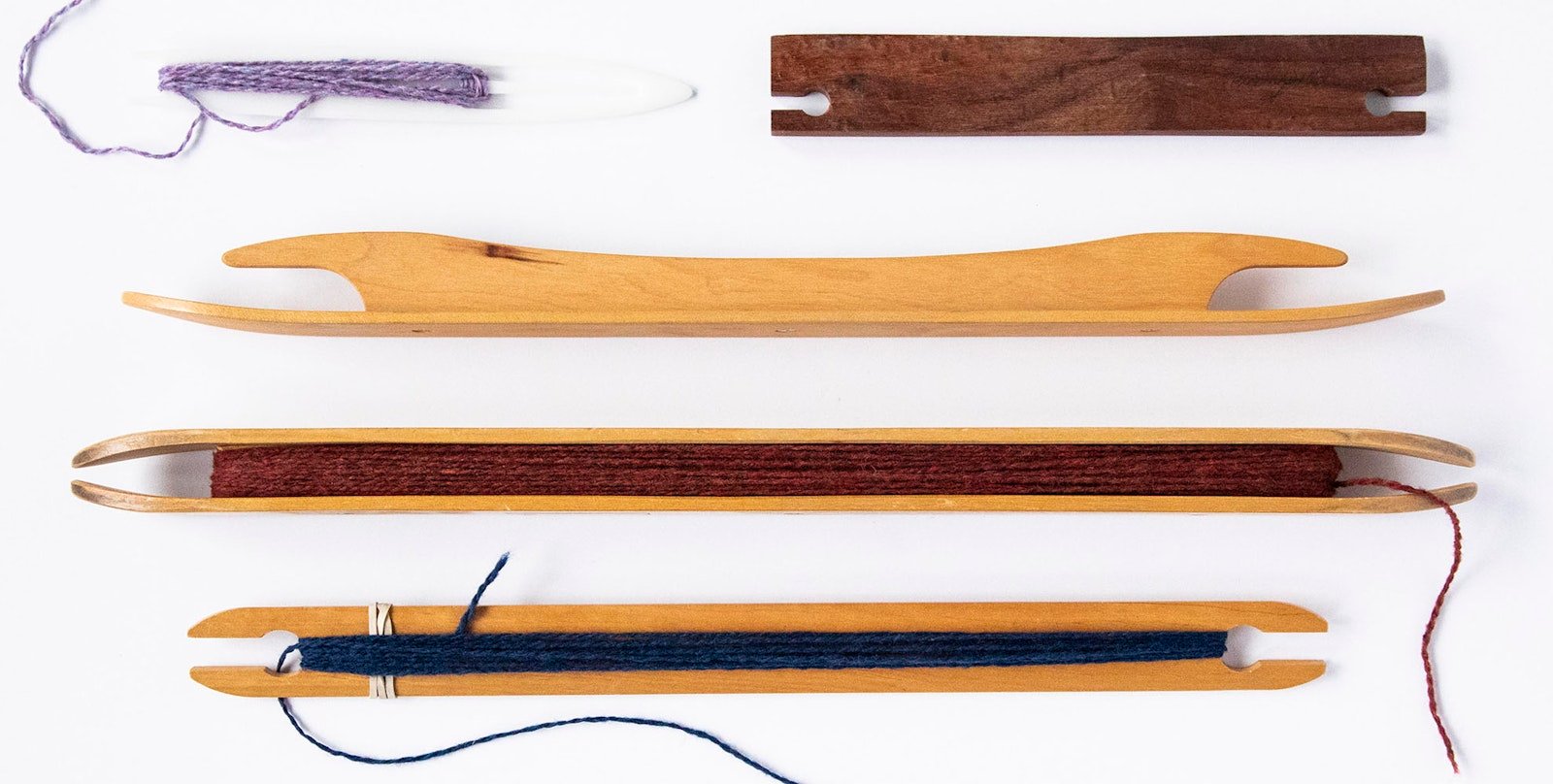Here is the second in our series about the main types of weaving shuttles. You can find the first part, about stick, belt, netting, and rag shuttles, here. —Susan
Today, I’m covering rug and ski shuttles, which I use constantly. I’ll share the basics of the shuttles’ form and function and why they work well for their respective purposes, with tips for selecting the best shuttle for you.

A rug shuttle has curved tips on the top and bottom at both ends.
RUG SHUTTLES are simple tools (but don‘t confuse them with rag shuttles, which I‘ll cover later in the series). You can use any shuttle for any purpose you like, but rug shuttles work especially well with the heavier wool or cotton weft yarns used in rug weaving.
Rug shuttles feature a full “ski” on both top and bottom with tips that turn inward at both ends, preventing the shuttle from diving down through the warp. Rug shuttles can usually hold quite a lot of weft, which is wound on from front to back. They are generally 16" or longer, and they work well without the support of a shuttle race.

In the ski-type shuttle, the middle section helps to hold up the upper ends in a narrow shed.
There are several styles of the ski shuttle (my personal favorite type of shuttle), and I’ll cover two of them here. All ski shuttles have one ski on the bottom, and most have a ski tip on both ends.
The SKI-TYPE SHUTTLE pictured above functions in the same manner as the rug shuttle. To load it, you wind the weft around the middle rib support. An arched set of wings faces downward to hold the weft in; those wings also hold up the upper ends of a narrow shed.

A true ski shuttle‘s short wings don‘t span its full length, which leaves room for a lot of weft.
The true SKI SHUTTLE has wings at both ends, but the middle section is simply the flat upper surface of the ski. These wings, which curve down at the front and back, accommodate a very large amount of yarn. Because you wind the weft in a figure eight on this shuttle, the bulk of the yarn (at the cross) actually lies lower than at the wings.
It’s imperative that the bottom of your ski shuttle be absolutely smooth. If it isn’t, use very fine (000) steel wool to buff it smooth as glass, and then apply a thin coat of paste wax (following the instructions that come with the wax). If you‘ve done a good job rubbing the wax in, the shuttle’s smooth glide will be evident right away, and there won’t be any wax residue transferred to your warp.
If you‘re not always careful inserting shuttles in the shed, the entry side of the shuttle can rub against the reed. After several warps, the finish on the back side of the ski will show some wear—another good reason to wax your shuttles.
Size matters
When considering what size rug or ski shuttle to use, you should think about your personal arm span.
My largest loom is 60" wide, and I can effectively weave a width of about 54". Since I prefer to sit on my bench while weaving, my reach is about 25" to either side (and another 4" if I lean). And here is my dilemma: My favorite ski shuttles are 25" long. If I were to reach 25" to the right and try to insert a 25" ski shuttle into the shed, I would need to hold it at the near end—and throwing it would be a serious challenge.
If you want to weave a wide piece while sitting, consider the length of your ski shuttle, the length of your arms, and whether you can reasonably make that stretch over and over as you weave. A longer shuttle may hold a lot of weft, but it might also be hard for you to use.
I‘ve solved this problem for myself by using a treadle gate on my 60" loom. I weave standing up, and I gate the treadles to hold the sheds open while I walk back and forth to insert the shuttle at each end. You can find more information about using a treadle gate in Handwoven May/June 2019.
Other important considerations in choosing a shuttle are its look and feel. Rug and ski shuttles are lightweight (generally weighing in at 110–170 grams, or 4–6 ounces). Holding them in your hand is the best way to know which ones are right for you.
I have a collection of beautiful butter-soft skis made by a craftsman who is, sadly, no longer producing them. If you find a source for well-made shuttles, it’s worth building a relationship—they may be open to customizing their work to your specific needs.
We’ll talk more about weight and balance in future installments when we investigate boat shuttles, which tend to be heavier—sometimes for very important reasons.
Originally published September 25, 2020; updated July 1, 2022; updated again May 8, 2024.

